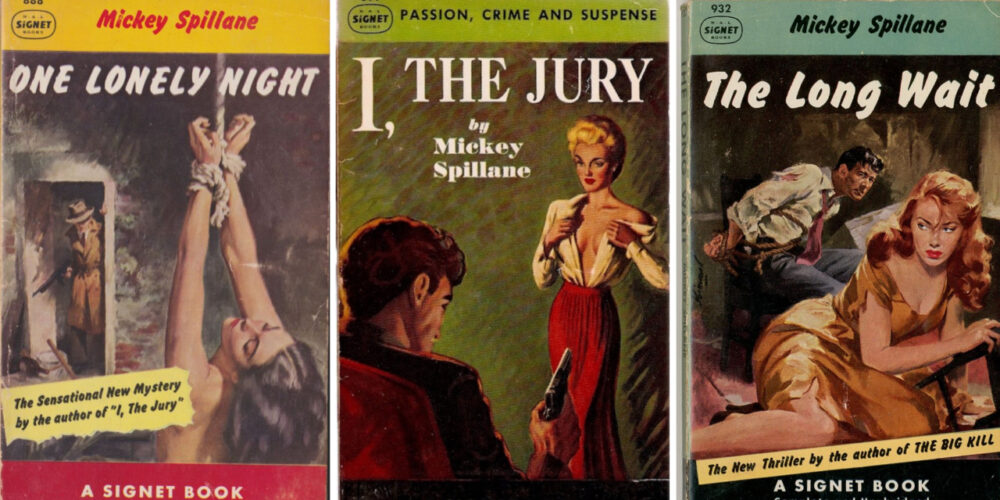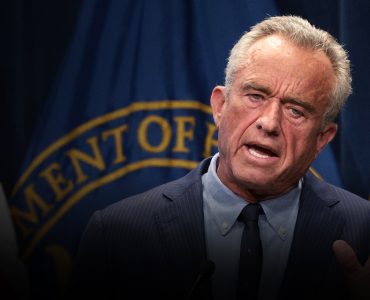In The Fountainhead, a writer who speaks up in praise of Howard Roark’s architectural achievement is described as someone “who is great enough to see greatness and say so.”1 Ayn Rand, of course, was great in her own right. She also set herself the task of recognizing and publicizing the work of an artist she judged to be brilliant. Rand identified the literary virtues of Mickey Spillane and offered him public admiration, as well as private friendship. She paid tribute to his well-constructed plots, his first-handed style, his passionate moralism, his uncompromised and uncompromising heroes.2
When, why, and how did she do this?
Mickey Spillane (1912–2006) is best known as the creator of Mike Hammer, a heroic protagonist first featured in I, the Jury, which has sold six million copies since its publication in 1947. Mike uses his gun, his fists, and his mind to avenge the innocent, to destroy the evil, and to guard the good. He lives by a personal code. He is not infallible or invulnerable, but he is unstoppable. Unapologetic. He knows what he seeks, and he gets what he wants. He works on his own, a private detective. He refuses to be hampered by bureaucracy that interferes with his purposes. Although he is frequently motivated by revenge and by a personal connection to the crime he is avenging, he is not a loose cannon. He is a cannon under control.
Many reviewers dismissed or condemned Spillane’s writing and Spillane himself; millions of readers, undeterred, devoured the books anyway. By 1952, Spillane had written six Mike Hammer novels and one stand-alone novel (The Long Wait, 1951). These seven books were among the top ten best-selling novels of the first half of the twentieth century. By now, more than 225 million copies of his books have been sold.
Ayn Rand discovered his novels in the 1950s, at a time when he was excoriated by critics and popular with readers. She praised his writing, as early as February 1958.3 In a private, informal fiction-writing course, she said:
In our question period last time, you remember someone mentioned that Mickey Spillane writes his endings of his stories first. Now, there is someone who has a marvelous plot sense and who, as far as one can judge from his books — I’ve never met him — is not philosophical or introspective at all. So without full philosophical identification, he has nevertheless arrived at the right premises about story structure. And that little bit of information would indicate to me as an absolute truth — taken in conjunction with the kind of plot structure that you see in his novels, the information that he starts writing his books from the end is a proof that he has at least a sense — even if he hasn’t identified it consciously — of how one goes about inventing a plot and constructing a story properly.4
In one lecture she analyzed the style of the opening of Spillane’s One Lonely Night (1951). Contrasting his description of New York with one by Thomas Wolfe in The Web and the Rock (1939), she points to specific highlights of Spillane’s “Romantic writing,” notably his selection of essentials: his describing “exactly what those faces would look like under the circumstances,” his word choice, his skill in conveying the character of the narrator/protagonist and the achieving of an “effect through great economy and precision.”5 She comments:
I have always wanted to throw this particular description in the faces of the critics who attack Spillane, because it reveals real literary talent. Unfortunately, he does not always live up to it; he has some sloppy passages in his writing. But you judge a person’s literary talent as you judge his intelligence: by what he has demonstrated as his best potential. If he can do this, he could bring all of his writing up to the same standard.6
She acknowledges the unevenness of his writing, and in this lecture she points to places where he “lets his standard slip.” She takes care to distinguish what she admires, Spillane at his best, from what she deems inferior or undistinguished. She thus demonstrates the attention she pays to doing justice, by giving credit where it is due and recognizing where it is not.
On March 10, 1958, she praised Mickey Spillane in public, before an audience including over a hundred book reviewers from national magazines and daily newspapers. Atlas Shrugged was one of the ten finalists in fiction for the National Book Award. (The other finalists included Vladimir Nabokov’s Pnin, Bernard Malamud’s The Assistant, and James Agee’s A Death in the Family. John Cheever’s The Wapshot Chronicle was the winner.) At a Publishers Adclub event one day before the presentation of the awards, Mike Wallace interviewed her. She criticized contemporary literature and reviewers but gave credit where she believed credit was deserved. Publishers Weekly reported:
Listing her own favorite authors, she named Victor Hugo, Dostoevsky, O. Henry and Mickey Spillane because their books have a “moral viewpoint,” plot structure and a sense of value. “Spillane,” Miss Rand said, “appeals to our moral sense. His heroes are true heroes, and his villains are true villains. He says, ‘It is,’ rather than, ‘It seems to me.’”7
She stated to a national audience, on a public occasion, the same merits she had emphasized to an audience of her admirers: Spillane’s creation of heroes, his “moral viewpoint,” plot structure, and objectivity. Publishers Weekly commented: “Miss Rand’s comments on the literary scene were controversial, and while all may not have agreed, nobody shrugged.”8
In 1961 Rand discussed her admiration for Spillane during a series of interviews with Barbara Branden recorded as the basis for a biographical project.
What I like about his writing as a writer, I admire his plot sense more than anything else, as that would always be the primary for me. But why I would like him more than other mystery stories is because he is a moralist, and even if his conflicts are in a primitive form of gangsters against detective, nevertheless, it’s the positive tone of black and white. . . .
He’s never canned. He never writes borrowed bromides. When he wants to make an effect, he might use bromides casually, but when he wants to create a mood, like that opening of One Lonely Night, or he wants to convey something literarily, it is always a first-hand observation that he puts down. So that you have the feeling: here is a mind looking through his own eyes and observing things. . . .
Asked why the critical establishment disapproved of him, she said:
It’s precisely because of that moral absolutism that I think, sense-of-life-wise, he antagonizes them as much as I do, or for the same reasons. It’s in the same category. It’s the whole anti-morality premise of today’s culture that would make people attack him.9
She adds that the “literati” are wrong to “accuse his following of liking him for sex and violence . . . because there are too many other writers who have sex and violence but not his following.”10 When she expressed admiration for him as a moralist and stylist, she was also contrasting him with other contemporary writers and was, in effect, contrasting herself as a reader with the “literati” who did not discern the quality of his work or did not estimate it as she did.
Ayn Rand and Mickey Spillane first met on August 21, 1961, at a lunch arranged by Jay Tower of New American Library, their mutual publisher. Over a period of several hours, perhaps as many as eight, they discussed the goals and practice of their writing, their views of each other’s work (Spillane had read and enjoyed Atlas Shrugged), their careers and other life experiences. They became friends.11
Spillane, looking back on their conversations, recalled discussing the very feature she had mentioned when she first praised his work: the technique of crafting plots to lead to an ending both unexpected and inevitable. When Spillane was interviewed in 2002, he was asked: Generally, what aspects of writing did you discuss?
We discussed subject matter, ways of writing a story. One of the things she always appreciated was the fact that people don’t read a book to get to the middle. They read a book to get to the end and hope the ending is so great that it justifies all the time they spent in reading it. You have to get to the end of the book and “Wow!” Now that’s the biggest part of the book. Anyway, we talked about things like that.12
In October 1961, they appeared together on Mike Wallace’s late-night talk show, PM East/PM West. The show was recorded on October 12 and broadcast on October 23. They spoke about the moral and literary values they shared, as contrasted with those of the contemporary culture. They affirmed their admiration of each other’s art and work. Rand’s assessment of his work was consistent with what she had said before: she especially admired Mike Hammer, Spillane’s heroic protagonist, as a moralist, and she believed that the moral absolutism she valued in Mickey Spillane was responsible for the critical neglect and disdain he had experienced, as contrasted with his popularity with readers.
Continue to Part 2 here
Do you have a comment or question?
Endnotes
- Ayn Rand, The Fountainhead (New York: Signet, 1993), 512 (Part IV, Chapter 1).
- This article is drawn from two presentations I delivered at Objectivist Summer Conference 2022 in Washington, DC: “Mickey Spillane: Crusader for Justice” (a general session, now available on YouTube) and “Ayn Rand and Mickey Spillane: Mike Wallace’s Interview Broadcast” (a lunch for ARI benefactors).
- Ayn Rand, Daily Desk Calendars, transcribed by Michael S. Berliner. Entry for Saturday, February 15, 1958: “815pm—Fifth Lit. Class,” Ayn Rand Papers, Ayn Rand Archives. In Rand’s notes for the course, she indicated that Lecture 5 (beginning with the climax of The Fountainhead) was planned for February 22, 1958. Ayn Rand Papers, Ayn Rand Archives, 013_64A_006_001. The dates in the day calendar coincide with dates in the lecture notes for lectures 1, 2, and 3, but not for lectures 4 or 5.
- Ayn Rand, Fiction Writing: A Thirteen-Lecture Course with Novelist-Philosopher Ayn Rand (New Milford, CT: Second Renaissance Books, 1994), lecture 5, side 1. The recorded version of the course does not include the question periods, to which Rand refers in this comment. To read an edited and reorganized version of the course, see Ayn Rand, The Art of Fiction: A Guide for Writers and Readers, edited by Tore Boeckmann (New York: Plume/Penguin, 2000).
- These quotations are drawn from an edited and reorganized version of the lecture course. Published as Ayn Rand, The Art of Fiction: A Guide for Writers and Readers, edited by Tore Boeckmann (New York: Plume/Penguin, 2000), 132–33. The points about Spillane’s style quoted here from the edited version are the same as those in the recording. The recorded lecture is available in Ayn Rand, Fiction Writing: A Thirteen-Lecture Course, Lecture 10, Tape 2, Side 1. Rand’s analysis of Spillane’s One Lonely Night in contrast with Thomas Wolfe’s The Web and the Rock was also part of her discussion of style in “The Esthetics of Literature,” which she delivered as Lecture 17 of the Nathaniel Branden Institute course on “Basic Principles of Objectivism.” See Ayn Rand Papers, Ayn Rand Archives, 109_31x_002_022; 109_31x_002_023. In print, Ayn Rand summarizes her comments on Spillane’s style in “Basic Principles of Literature” (The Objectivist, July–August 1968), reprinted in Ayn Rand, The Romantic Manifesto: A Philosophy of Literature, revised edition (New York: Signet, 1971), 94–96.
- Rand, The Art of Fiction, 133.
- “Just Mickey and Me,” Publishers Weekly, March 24, 1968, 16. Thanks to Tom Bowden for helping me locate the source of the articles in Publishers Weekly.
- “The Ninth National Book Awards Given for Fiction, Nonfiction, Poetry,” Publishers Weekly, March 24, 1968, 19.
- For Rand’s discussion of the concept of “sense of life,” see her essay “Philosophy and Sense of Life” in The Romantic Manifesto: A Philosophy of Literature. https://courses.aynrand.org/works/philosophy-and-sense-of-life/
- Biographical interview of Ayn Rand by Barbara Branden, April 19, 1961, #16, tape 9, side 1. Ayn Rand Archives.
- For the tenor of their relationship, see, for example, his letter of August 28, 1961 (Ayn Rand Papers, Ayn Rand Archives, 101_13C_010_001). For his extended recollections of their friendship, see the interview with him, conducted on March 8, 2002, and published in Scott McConnell, 100 Voices: An Oral History of Ayn Rand (New York: New American Library, 2010), 232–39.
- McConnell, 100 Voices, 232–33.







